E-Archive
Articles
in Vol. 8 - September Issue - Year 2007
Drag Finishing Improves The Quality Of Forming And Stamping Tools

Author: Dipl.-Ing Helmut Gegenheimer, Managing Director
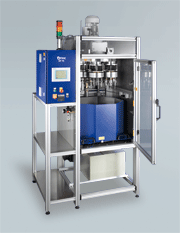
In order to design machines for the drag finishing of tool parts, precise details concerning the dimensions of the required edge rounding are needed. Photo: Otec
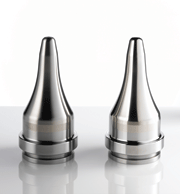
Fig. 1: To process moulding dies effectively in drag finishing machines it is necessary to produce the best flow of media at the tool surface (moulding die before and after processing).
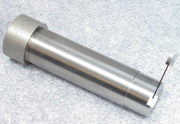
Fig. 2: stamping tool
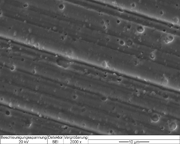
Fig. 3: The drag finishing process has removed the droplets without roughening the surface. The resultant cavities and depressions can absorb coolant and thereby increase tool life.
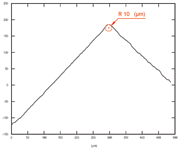
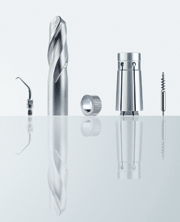
Fig. 4
In the manufacture and regrinding of forming and stamping tools, the drag finishing process not only eliminates extensive manual polishing with oil stones but also improves the quality of the cutting edges and surfaces. This has a distinctly beneficial effect on the life of the tools themselves and on the quality of the workpieces. And there is absolutely no risk of any damage to tool parts occurring from the edge rounding process.
Regular regrinding makes tools usable again. In this process the edges are resharpened, contact surfaces of dies, punches, ejectors and material infeed edges are smoothed in order to obtain the best flow characteristics for the forming materials. As a rule, the cutting edges are treated with an oilstone.
However, this manual form of processing guarantees neither adequate reliability nor reproducible quality. Studies have shown that automated micro-rounding of cutting edges offers a variety of significant advantages.
Tool-related down time is reduced
Rounded edges in the micrometer range improve edge stability, prevent the formation of built-up edges and generate less frictional heat during the forming process. This gives increased tool life and at the same time improves the technical quality and the appearance of the product. This is made possible by means of the drag finishing process: a form of vibratory grinding which has its origins at least partly in the jewellery industry.
During processing in OTEC DF machines the workpieces are clamped in special holders and dragged at a high speed through a container filled with a processing medium of special granulate. The main advantage of this is that bur-free, smoothed or polished surfaces are generated in a very short time with no danger of the workpieces being damaged through colliding with one another.
Drag finishing is suitable for many applications
Because it provides reliable and accurate processing of delicate and intricate workpieces, this process has now conquered the market for even more applications. In particular, smoothing the surfaces of tool parts with complex shapes is as a rule very time-consuming and must be carried out by highly skilled staff. The drag finishing process on the other hand is not only easier and faster but also improves the quality of the tool surface.
The controlled movement of the fixed workpieces eliminates all risk of damage to the workpieces as a result of them colliding during the processing cycle. Clamping the tools at the correct angle ensures the best flow of media at the tool surface (Fig. 1).
Roughness measurements before and after processing in a drag finishing machine:
Example 1: moulding die
Before: Ra: 2.04 Rz: 10.9
After: Ra: 1.00 Rz: 4.1
Example 2: embossing tool
Before: Ra: 0.45 Rz: 2.6
After: Ra: 0.13 Rz: 0.8
The measurements speak for themselves. In only two processing stages, the surface structure has improved from Ra 0.4 to Ra 0.06.
The secret of successful processing lies in the ideal combination of media, speed of rotation and the clamping angle of the tool. In the case of punches, it is important that the cutting edge is not rounded too much - as a rule a maximum of 8 to 10 µm. Even in professional circles such a delicate and precise machine finishing process is considered to be a major innovation. Even key international customers are impressed by the results that can be obtained by the drag finishing process.
For example, the production manager of a world wide electronics group admits that such accuracy in the micrometer range would previously not have been thought possible.
Optimized surfaces improve product quality
Detailed studies of the surface and structures of tools and workpieces show the effect that the drag finishing of shaping tools has on the manufacturing process:
The
roughness peaks of the tools are smoothed or the peaks are rounded (as
shown in the table). This means that less force is required for the
forming process. There is less tendency of the workpiece material to break
since improved flow properties during forming lead to a more efficient
exploitation of the yield point and elastic limit of the material. The
percentage contact area of the tool edges can be increased to as much as
95% by smoothing the roughness peaks. Lowering
the coefficient of friction reduces wear at the tool surface and increases
tool life. In many cases tool life can be doubled. Reducing
the roughness also lowers the risk of cold welding between the workpiece
and the tool. For example, less force is required for ejecting or
stripping and this reduces the rate of rejects from accidental bending. The
grain structure of the material is not adversely affected by rough,
untreated surfaces. The
surface quality of the machined products is improved by the drag finishing
process (Fig. 2). The quality remains constant for a longer period of the
useful life of the product.
In addition there are cost benefits resulting from the more economical drag finishing process when compared to conventional processes such as abrasive flow machining or manual grinding. Processing in a drag finishing machine is considerably more cost-effective and much faster. The required processing times range from a few seconds, for example for the edge rounding of thin tungsten carbide punches, to a maximum of two hours for forming tools with a relatively high degree of initial roughness. In short, this means that there is less down time for maintenance work and therefore a greater capacity usage of the production line accompanied by a better surface quality in the workpieces processed.
Stamping and forming dies are often coated to reduce wear. During this process, so-called droplets form on the surface of the workpiece. These are in fact congealed globules of the coating material. The drag finishing process removes these droplets. The minute cavities and depressions which they leave behind can serve to retain lubricants such as oil during the forming process. The result is a better film of lubricant and a considerable increase in tool life. This effect can be observed in both forming and stamping tools. (Fig. 3).
Pockets of lubricant are created by removing droplets
In addition to the process parameters already discussed, the choice of the correct processing medium plays an important part. SIX granulates are suitable for preparing (levelling) coarse surfaces prior to polishing , for example for the deburring and edge rounding of tungsten carbide tools and tool steels. For less coarse surfaces the harder HSC granulates are to be recommended for the same purpose.
Walnut shell granulates are used for the smoothing, polishing and gentle rounding of unhardened tool steels, for polishing tungsten carbide tools and hardened tool steels after the surfaces have been prepared with SIX and HSC granulates. Field tests have shown that good results are obtained by using a mixture of H 1/100 and H 1/400 (approx. 30% volume H 1/400) and polishing paste P 17.
There are virtually no limits to the applications of drag finishing for the processing of tools (Fig. 4). Generally speaking, all clampable workpieces up to 250 mm in length and 200 mm in diameter can be processed. The process minimizes the friction on tools used for the forming or cutting of metals or plastics, those which are subject to mechanical wear and those which have received or are due to receive a protective coating. For operational components such as gear wheels and components for motor racing vehicles and for the aerospace industry, drag finishing offers an affordable and effective method of optimizing surfaces.
For Information:
OTEC Präzisionsfinish GmbH
Dieselstr. 8-12
75334 Straubenhardt-Feldrennach
Germany
Tel. +49.7082.491133
Fax +49.7082.491129
www.otec.de



























